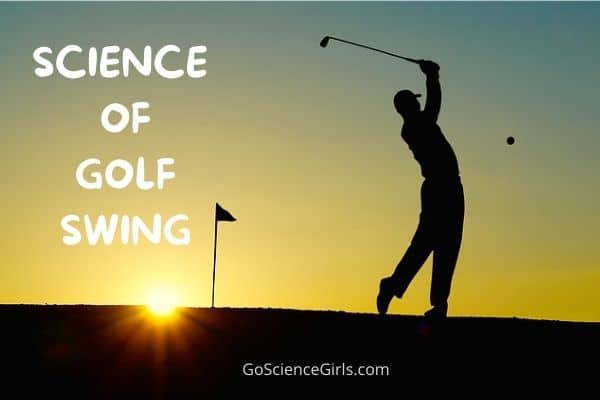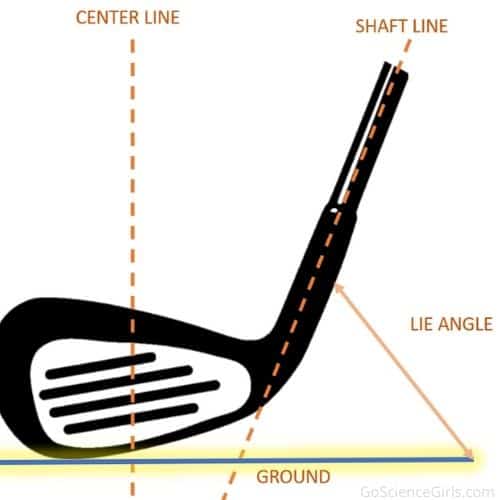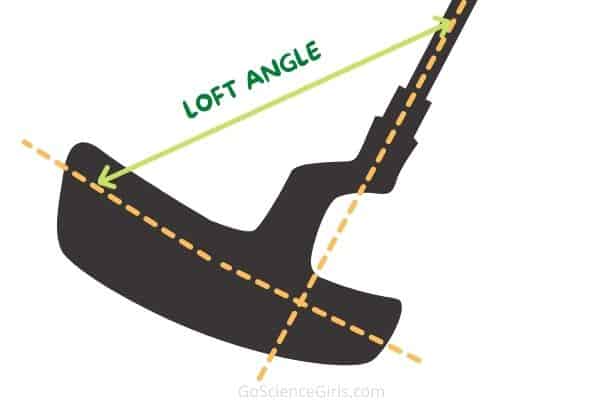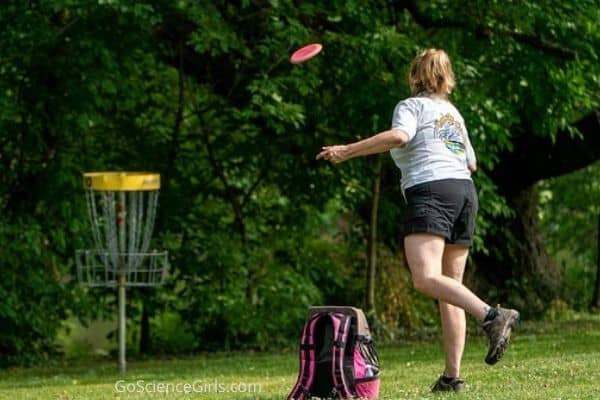Golf is a game that has fascinating concepts of physics.
Understanding these simple laws of nature and physics concepts would help a player to understand the game better.
The Science concepts include aerodynamics, inertia, impulse, momentum, forces, trajectory, etc.
Science of Golf Swing
Torque
Torque is the measurement of how much force acting on an object changes its force of rotation. It refers to rotating the shoulders to prepare for the drive and twisting the hips while swinging in golf.
For example, a door is difficult to open when you move it from the hinge, but the rotation of the handle makes it easy.
It is also related to the Law Of Conservation Of Energy. The energy for the swing doesn’t originate in the wrist. It travels from the shoulder muscles to the core, the arms, the wrists, and finally to the golf club and ball.
Theoretically, the more torque you apply, the more force you will create, and the ball will go farther.
However, if you use too much torque too quickly, the club will reach its maximum speed before it hits the ball.
So, the torque and the timing should be ideal. Rotate the hips, strike with the shoulders first while holding back with the arms and wrists. After some delay, let it go.
Scientists revealed specific angles of torque consistent to most professionals- done to increase drive distance.
The rotation of the hips relative to the shoulder is an average of 56 degrees, the angle of the upward tilt of the leading shoulder is an average of 25 degrees, and the top of the hip tilted 12 degrees up.
This posture proved to be consistent in large drive distances, and any deviation decreased the strength of the shot.

The Double Pendulum Effect
In physics, the double pendulum is a pendulum with another pendulum attached at one of its ends.
The first pendulum oscillates from a fixed pivot point and the second one from the end of the first one.
In golf, your arms, wrist, and golf clubs create a double pendulum effect.
The first pendulum is your arms, with shoulders being the pivots- the upper pendulum. The second pendulum is the golf club, with wrists being the pivots-the lower pendulum.
The efficient working of the double pendulum creates a powerful drive.
At first, when the club is held high up, both wrists remain relatively flat. As the swing begins, the back hinge starts to hinge, showing cupping motion.
The wrist, the back of the hand, and the forearm create a cup-like shape. Further, towards the bottom of the drive, the front wrist begins to hinge towards the target. This motion is known as a wrist cock.
The proper wrist cock is imperative for a strong swing. Too long, the ball will swing sideways, away from the target.
Too short, the speed won’t be enough, and the ball will travel a shorter distance. The wrist allows the kinetic energy to travel from the arms to the club to the ball, and thus, their position is crucial while playing golf.
Centripetal Force
Centripetal force is the net force applied to a body to keep it moving in a circular path. It’s directed towards the center of the circular path.
For example, the gravity of the earth (originating from the center) acting on a satellite in outer space to help it keep moving in orbit is an example.
In golf, pivoting your hips and lower body, and inward movement of the wrists, and the outward motion of the golf club creates centripetal force.
Have you noticed that golfers play with long golf clubs during tournaments? This is because the longer the radius of the circle, the less force you have to apply to keep the rotation going.
Therefore, the length of the golf club is directly related to centripetal force and, in turn, related to how far you can hit the ball.
Conservation Of Angular Momentum
The Law of Conservation of Angular Momentum states that when no external torque acts on a body, the angular momentum of the closed system will remain constant.
For example, when a spinning ice skater pulls in her arms, she starts rotating at an incredible speed.
Her work in moving her arms directly leads to an increase in kinetic energy, as angular momentum is always conserved.
In golf, early in the downswing, the club stays closer to the player. This helps them maintain their rotational speed, just like the ice skater pulling in her arms.
Then, as the forelimbs gradually change direction, the club has to follow. This creates a greater rotational speed, higher kinetic energy, and the ball goes farther.
Science of the Proper Golf Grip Size
While playing golf, it’s essential to find a grip size that is perfect for you. It makes a difference in how well you swing the handle.
The vital thing to know is that oversized hands-bigger grip, smaller hands- smaller grip is a myth. If you’re having trouble hitting good shots consistently, make sure this isn’t because of your grips.
The science behind a smaller grip
If you have a smaller grip than what you require, the smaller hand and finger muscles have to work overtime.
This makes you lose control over the club and the ball. The ball becomes hyperactive, and the number of hook shots you hit increases in number.
All in all, having a smaller grip isn’t suitable while playing golf.
The science behind a larger grip
If you have a larger grip than you require, precisely the opposite will happen. The smaller hand and finger muscles lose the ability to engage with the club.
The grip restricts movement and causes you to lose swing speed and, ultimately, distance. So, both these reasons are why finding one should not ignore the science of finding the proper grip.
Science of Golf Clubs, Loft Angle, and Distance
Science Behind the Golf Club
Weight
Different golf clubs have different weights, lie angles, and head sizes. However, the heaviest, the driver, one is used to start the game.
This is because a large amount of energy is transferred from the clubhead to the ball, and it travels a more considerable distance.
Further, the golf club head is hollow. This allows the weight to be distributed along its perimeter. If the weight were concentrated at one point, the ball would turn, and the distance would decrease.
Lie Angle
This is the angle between the club shaft and the ground. It’s different for clubs of varying lengths, but there’s an average of 50 degrees in drivers and 60 degrees in short irons.
This dramatically affects the direction in which the ball swings. A proper lie angle produces straighter shots more consistently.

Grooves
Grooves running horizontally across golf clubs are like treads on our shoes. When these treads lock with the irregularities in the ground, the force of friction acts, allowing us to walk.
Similarly, the grooves on the ball provide better contact and control. They allow water and debris to move away to leave fewer barriers between the club and the ball.
Furthermore, they create backspin on the ball, allowing it to stay in the air for a longer time. It allows for a better loft.
Science Behind The Loft Angle
The Loft Angle is the angle between the clubface and the ground. It plays a significant role in determining the height and spin of the ball.
Again, it’s varying for all clubs. The lower the loft angle, the farther the club goes! As explained earlier, the drivers need to hit the ball farthest. So, can you guess the club with the lowest loft angle?

Drivers have a loft angle of approximately ten degrees. So, they hit the ball low and far. However, particular wedges can have loft angles of up to 60 degrees.
They hit the ball high and close! Therefore, the loft angle is directly involved in how far the ball will travel.
Science Behind the Distance
Imagine two pendulums. One has a longer string; the other has a shorter one. The weight at the end of both the pendulums is the same.
Which pendulum will show more oscillatory motion and travel a longer distance? Of course, the longer one.
Similarly, a longer golf club creates more force and hits the ball farther.
But, a too long or too short one will mess up your stance, and the distance will decrease. So, finding the perfect club for your height and stance also has a base in science.
The Science of Hitting
We’ve all heard of the Law of Conservation of Energy. It states that energy can neither be created nor destroyed.
One can simply convert it from one form to another. When we hold the stick aloft, we transfer the potential energy in our muscles to the club.
Now the club has energy by virtue of its height. As we start the swing, we convert potential energy to kinetic energy, that is, the movement by virtue of motion.
When we hit the still ball, the energy from the club flows into it, and it comes into action. This way, energy is conserved in this reaction.
When the club hits the ball, the impact allows it to move. In physics, the impact is a high force applied within a short period when two bodies contact one another.
The higher the speed, the higher the force applied, and the longer the golf ball will travel.
Earth Science Behind A Golf Course
Earth Science is the study of all physical and chemical components of this beautiful planet and its atmosphere.
Surprisingly, golf creates an impact of this as well! This is because it does its part to protect the environment and accelerate sustainable development.
Let’s look at how golf courses worldwide help save the environment!
Silver Lakes Golf & Wildlife Estate, South Africa
This golf course in South Africa truly lives up to its name. It gives a home to several species of birds and wildlife.
It created a true sense of being one with the environment by installing flotation islands to increase breeding, using organic fertilizers, recycling waste, and improving water consumption.
In fact, the open space in all golf courses is suitable for the growth of several animals and birds!
Sentosa Golf Club, Singapore
This golf club creates a high standard for all golf courses worldwide to follow.
Lithium-ion buggies to decrease their carbon footprint, recycling rainwater, using bio-friendly products, and avoiding plastic are only some of the measures they took to conserve the environment.
Streamsong Resort, Streamsong, Florida
This golf course was built upon an old potash and phosphate mine. The owners have challenged all conventional measures used in regular golf courses.
Golfers have to walk; no vehicles are provided. Additionally, they only irrigate the area required for playing. This way, they conserve a lot of water.
Flowers aren’t planted, no streetlights, entrances aren’t lit. We see golf in a new light!
Science of Disc Golf
In disc golf, players throw discs at a target. It is played with rules similar to golf, usually with 9 or 18 holes. However, a lot of factors affect the ideal way to throw a disc. These include:

- Speed
In physics, speed is the rate at which an object covers distance.
Similarly, in disc golf, speed affects how much space the disc covers, how fast the disc goes, and how quickly it can reach the target.
It also affects stability. Too much or too little speed can cause the disc to spin and deviate from its original path.
- Lift
In physics, lift is a force exerted by a fluid on the object moving through it. This force opposes gravity and keeps the disc in the air.
The disc has weight; therefore, gravity tries to pull it down.
However, lift is one of the factors that keep it flowing through the air. The more the lift, the more the time the disc is in flight.
- Attitude
In physics, attitude is how an object is placed in the space it occupies. In disc golf, it refers to whether the disc is pointing up, down, or is level.
It determines how far it will travel, despite the force you put behind the throw or other techniques you use.
For example, if it’s pointing up, it will attain height but not travel very far. If it’s pointing down, it will just crash into the ground in front of you.
Therefore, it’s essential to keep the disc level while throwing.
- Spin
Spin is defined as the constant rotation of an object. Have you ever seen a flying frisbee?
The phenomenon of that frisbee rotating around its center is known as spin. It’s one of the most critical techniques of disc golf.
Spin allows the disc to cut through the air and go a considerable distance. The amount of spin required depends on the stability of the disc as well.
If it’s understandable, the disc will deviate to the right. If it’s overstable, the disc will veer to the left. Proper torque is required to keep it moving towards the target.
- Aerodynamics
The ability of the disc to cut through the air is dependent on aerodynamics.
For example, the airplane is streamlined-shape, like a bird, to overcome drag (the force applied by the wind to oppose its motion).
Similarly, various discs are shaped in different ways to combat drag.
Since drivers have to travel the longest distance, just like in golf, they have the sleekest rim. This helps them to travel a longer distance.
- Roll (Bank)
Roll determines which direction the disc will travel in.
For example, if the lowest point of the disc is towards the left, it will travel towards the left. If the lowest point is towards the right, it will travel towards the right.
Therefore, it is critical to note the direction of the target and then angle the disc in the same way.
Science Of Forehand Disc Golf
In disc golf, your arm is your lever. In physics, a lever is a body capable of rotating on itself. For example, the arm is the input force, and the disc flying is the output.
The larger the distance covered by the arm, the more efficiently the energy works and the farther the disc goes. The figure below describes how much space is covered in an ideal throw.
Sometimes, when the disc is released improperly, it wobbles. This causes it to spin more and change its angle. Observe the figure given below.
Look at the angle of attack. When the disc is thrown, it is low and gradually becomes more extensive.
When it is lower, less surface of the disc comes in contact with the air and experiences drag.
When it’s more significant, the amount of drag force applied increases, and the disc falls to the ground. So, if the throw isn’t ideal, the disc will not go very far. It will fall to the ground.
Law of Force and Acceleration
Newton’s Second Law of Motion, i.e., the Law of Force and Acceleration, has a significant impact on golf.
It states that the acceleration produced by the unbalanced force on an object is directly proportional to the magnitude of the force and inversely proportional to the mass of the object.
Therefore, golf balls are smaller to allow them to go a more considerable distance. Also, this is why strength and technique are fundamental when it comes to golf.
Science of Golf Ball Dimples
Golf ball dimples help the ball fly a larger distance. Why? Let’s find out.
When wind finds a surface blocking it, it tends to stick to that surface. When the current flows over a smooth ball, it follows a steady path. This is known as a laminar boundary layer.
Look at the diagram below. When the wind is flowing over the smooth ball, it creates a large vacuum area on the backside of the ball.
However, when the wind flows over the dimpled ball, it sticks more and forms an irregular boundary with twists and turns.
This boundary has less flow separation and is known as a turbulent boundary layer. Observe the vacuum area behind the ball. Is it smaller or larger?
Now, it’s fundamental physics that it’s easier for a ball to travel in a vacuum than in air. This is because particles in air exert a force (drag) on it.
Therefore, since the smooth ball has a more significant vacuum behind it, it experiences more resistance and drops to the ground quickly. So, it travels a shorter distance.
However, in a dimpled ball, the area of the vacuum is less. Therefore, the ball’s less tendency to fall back to the ground.
So, it remains in the air for a long time and travels a longer distance. Did you know that a dimpled ball travels nearly twice as much as a smooth ball?
That’s how important these hundreds of tiny holes are!
The Science Behind Hitting A Golf Ball
The Sweet Spot
In golf, the sweet spot is the specific point on the clubface, from where maximum energy is transferred from the ball to the club.
Usually, it’s in the middle, a little below the actual center of the clubface. It is no bigger than a pin and approximately a quarter of an inch wide.
Hitting this sweet spot is essential for appropriate impact. If the golfer hits away from the sweet spot, the energy is not efficiently transferred.
This leads to an increase in spin and deviation from its desired path. This is because the clubhead twists at impact.
Maximum momentum will be transferred into wasted vibrational energy, making the club shake instead of making the ball fly.
When the club is hit from the sweet spot, its center of gravity aligns with the ball’s, and both centers contact one another.
This leads to an adequate transfer of energy. Thus, when the club is hit with a square face and powerful swing in the sweet spot, the ball flies level and true, towards the target.
Science of SuperSpeed Golf
Do you remember the first time you rode a bicycle?
The first time you ride a bike, you wobble and fall, but when you learn how to ride it, you can’t believe you ever couldn’t.
Then, if you try and ride a bicycle in which you have to pedal harder to keep it moving, you feel uncomfortable.
This is because your muscles and brain expect a certain amount of force requirement. If this increases or decreases, your body isn’t used to it, and thus, feels uncomfortable.

On the same principle, SuperSpeed Golf introduced Overspeed Training.
It aims to train your brain and muscles to expect a faster swing, regardless of the weight of the golf club. It makes the body believe that it can swing the club faster. How does this work?
The Overspeed Training includes working with three different training sticks- one weighing 20% less than the standard driver, one 10% less, and one 5% more.
The lighter it is, the easier it is to swing, Or is it? Let’s find out. First, take a look at the sticks!
Let’s assume your original speed of swinging the driver is approximately 100mph. Now, you start with swinging the lightest stick as hard as you can.
You’ll probably be able to swing it at a speed of 118-120 mph. Then you move to the medium-weight one.
Since your brain remembers the momentum the first one was able to swing at, it will expect the same velocity for this one.
You’ll be able to swing this club at 115 mph. Now, we’ll move on to the heaviest one. Once again, the brain expects the same neuromuscular reaction.
Finally, when you get back to swinging the standard driver, your swing speed will have increased to 110-115 mph.
This is a significant difference when it comes to golf. When done consistently, this change in speed will become permanent.
Of course, you know how speed and velocity impact the distance the ball travels!
Science of Compression Elasticity in Golf
Compression elasticity in golf provides you with the maximum distance, low spin, and more feel. But what is it?
In physics, compression refers to the decrease in volume of a substance due to applied stress. In golf, it indicates how tightly wound the core threads are.
At the same time, elasticity refers to the property of a deformed material to revert to its original shape.
Different balls have varying rates of compression and elasticity. A low compression ball flies farther but is harder to control.
A high compression ball covers less distance but is easier to direct.
A medium compression ball is the perfect mixture of distance and control! The type of ball you use depends on your level of play.
Best Science of Golf Books
Sometimes you just want to curl up into your blanket with a fantastic cup of coffee and a fascinating book. Especially during quarantine, when you can’t go and hit the ball around. So,
What’s a budding golfer to do? These are a few ‘Science of Golf’ books that will expand your knowledge of golf and physics to solve your problem.
- The Mad Science of Golf: On Moving Past Golf Industry Hype and Learning to Play Better Golf by Philip Moore
Being one of the most revolutionary books on golf, this book explains how golfers and golfing equipment have the power to improve in the future. It explains the importance of being true to golf and yourself. All in all, a good read!
- Golf Science: Optimum Performance from Tee to Green by Mark F. Smith
Mark F. Smith explores all scientific concepts involved in getting the golf ball into its hole. This book is informational rather than instructional and benefits players at all levels! It’s a highly detailed book, tailored to golfers’ interests!
- Golf’s Holy War: The Battle for the Soul of a Game in an Age of Science by Brett Cyrgalis
Time stands still while reading this book. It details the technological improvements made in the field of golf and what the future holds. It gives a great perspective on what will win: long-established tradition or technological future.
Science of Golf – Videos
Not a book person? Better with YouTube? Don’t worry; we got you. Without further ado, these are the videos with the best visuals, instructor, concepts, and demonstrations, that explain the Science of Golf!
- Science of Golf: Work, Energy, and Power
(https://www.nbcnews.com/video/science-of-golf-work-energy-and-power-32096835526)
Renowned golfer Suzanne Peterson explains the most important concepts in physics essential for the art of golf.
- ‘Learning Golf Through Science’ playlist by USGA
(https://www.youtube.com/playlist?list=PLnU5qUEfww3cl3HSqmqU5qdXazsGDz1TU)
This playlist, uploaded by the United States Golf Association, contains a list of 6 short videos. These include several wide-ranging videos such as physics behind the golf club, dimples of the golf ball, and the science behind a golf swing.
- 10/04/8 Robert Grober- The Physics of Golf
(https://www.youtube.com/watch?v=MRnjedSebWY&t=1s)
Science Saturdays at Yale are always interesting to watch. However, golfers will love this- Professor Robert Grober telling them about his two obsessions- physics and golf. His words, not ours!
The Conclusion:
While holding the club up in the air, swinging it, hitting the ball, the ball moving up into the air, and eventually falling, a thousand physics concepts are being applied.
Understanding these concepts will inherently make you a better golfer, even if you’re a beginner!
